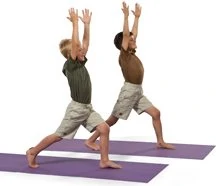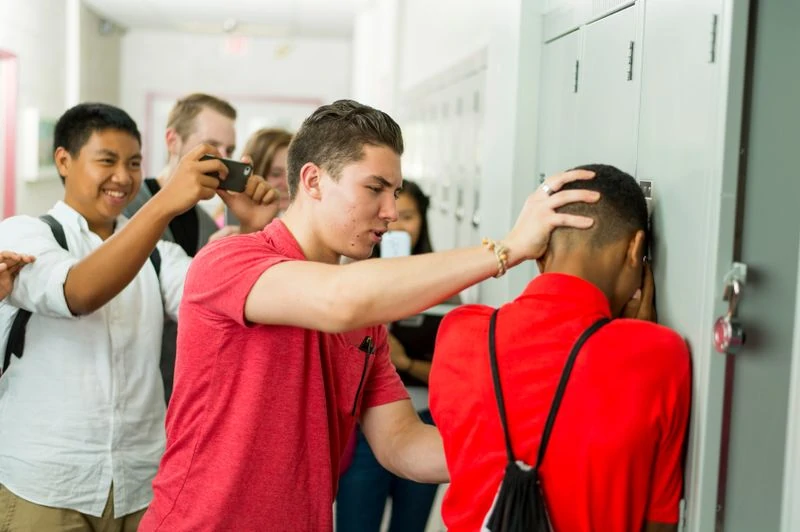One concept we talk about quite a bit in our Yoga Calm trainings is the power of modeling behavior – whether it’s the teacher’s modeling for the students or students modeling for each other. It’s one reason why mindfulness is such a critical skill to cultivate in ourselves, as well as our students. The more aware we are of how we are and the environments in which we work, the more able we are to adjust, adapt and create positive spaces for teaching and learning to occur.
The matter underlies a recent article by kids’ yoga instructor Colleen Cash, who teaches at the studio of one of our newest Yoga Calm Certified Instructors, Allyson Copacino. Colleen has graciously allowed us to share this piece, which originally ran on Move Yoga Studio’s blog and looks at the great impact a teacher’s emotions have on their students.
Being conscious of your emotions is key when teaching yoga for kids. Parents are well aware of how kids soak up their surroundings, including the emotional state of the people around them. A child will behave very differently at a birthday party, for example, than he or she would at the library. Some of that has to do with the behavior expectations that adults set. But even without behavior guidelines, kids are like energy mirrors; they will reflect back whatever emotional tenor is created around them.

Last semester, I had a particularly challenging afterschool yoga class. Several of the children were “showboats.” They liked getting the attention of their peers, and they sometimes chose disruptive behavior to do so. Moreover, there was one especially sensitive boy in the class, and I noticed that he tended to have an emotional breakdown whenever the room environment got too chaotic.
After a week or two of struggling to maintain a peaceful atmosphere in the class, I vowed to show up at least a half hour early to give myself time to plan our classroom procedures, to create a new rules poster guiding behavior, and to relax. And I did notice an improvement in the children’s behavior as a result. They were more receptive, calmer, and more prepared to listen. We were able to practice deep breathing when I felt the energy rising too high. Overall, it made for a much more conducive learning environment.
Certainly, the classroom management tactics helped.
buy isotretinoin generic over the counter
Preparation is more than half the battle when keeping a group of kids focused. But I am certain that my own emotional preparation before class had as much to do with the positive outcomes.
Last term, I noticed this pattern – students reflecting my emotional state – even more with one of my preschool yoga classes in southeast Portland. If I walked in full of energy after a morning workout, the kids’ behavior would be more energetic and chipper, as well. On the other hand, if I meditated before class, my grounded way of being would be reflected back to me in their behavior.
I remember one day where I had at least a half an hour before class to practice pranayama (breath work) and meditation before teaching at that preschool. I was stunned by how the kids acted that day! They spoke more quietly, their eyes moved around the room more slowly – even their body movements were slower and more focused. They reminded me of my experienced adult yogis – and these preschoolers were just three and four years old!
buy Pepcid generic over the counter
As social creatures, we can’t help but reflect back the emotions of those around us. As we evolved, we learned to watch others’ facial expressions for quick reads on any dangers that might be approaching.
Think about a flock of geese, or a herd of antelope. You’ll always see one or two looking around while the others eat or drink. That individual is the whole group’s alarm system. Early humans had the same approach to group safety. Brain researchers have even found a specific type of brain cell – mirror neurons – that help us detect and feel the emotions of those around us.
We really do reflect back how others are feeling. If you smile in front of me, chances are I will end up smiling too. How many times have you noticed yourself yawning because someone in front of you yawned?
This concept also has roots in education. As a student teacher in grad school, I learned about affective learning. If a child feels threatened, scared, sad, or any other huge, negative emotion, he or she will not be able to learn as well. Indeed, brain scientists tell us that the portions of the brain responsible for processing complex new information literally turn off when we’re in a stress response.
So when you’re choosing a yoga class for your child, pay special attention to how the teacher treats you. If you walk away from your interaction feeling peaceful, chances are your kids will have a similar experience in class. On the other hand, if the yoga teacher strikes you as pushy, rushed, or otherwise negative, you might select a different program. Those same emotional patterns will surface in the teacher’s classes, and the kids will likely pick them up on some level as well.
Children learn as much from our explicit lessons as from our underlying, unspoken lessons, including our emotions.
For those who teach yoga to kids and families, here are a few ideas on how to center yourself before launching into class:
- Give yourself an extra 10 to 15 minutes before class starts. This will not only prevent you from becoming stressed at unexpected delays (traffic!); it will also allow you to relax, knowing you have ten extra minutes to breathe before you teach.
- Pay attention to the inputs you take in before class. Consider turning off the radio if you’re driving. Instead, enjoy the blissful silence of your drive as you focus on taking deep breaths.
- Once you arrive, stay in your car a few minutes. Use positive affirmations to set intentions for how the class will go. For instance, you can say out loud to yourself several times, “I am a wonderfully positive kids’ yoga teacher. My students leave class feeling peaceful and happy. They reflect my groundedness in their own behavior.”
- Other ideas for taking advantage of travel and pre-class time include pranayama work, mantras, or playing music that makes you feel happy and free. If my day has been stressful before I teach, I keep it simple and just practice deep belly or bumblebee breaths on my way to class.
Thich Nhat Hanh, the Dalai Lama, and Saint Teresa recognized that world peace begins in each individual. The energy that we put out into the world will be multiplied. If we cultivate peace within ourselves, there will be more peace in the world as we share that peace with those around us. Even if we don’t explicitly choose to share our emotions, they affect our family members and friends, and even strangers. (Think about how you treated that last checkout clerk at the grocery store: Did the clerk get a pick-me-up or a downer from your interaction?)
As teachers, we teach far more than just yoga postures or arithmetic tricks. We teach how to act by exhibiting our own behavior in the classroom. To grow peace among your students and in the world, take time to create a positive emotional starting point first, before class begins.






